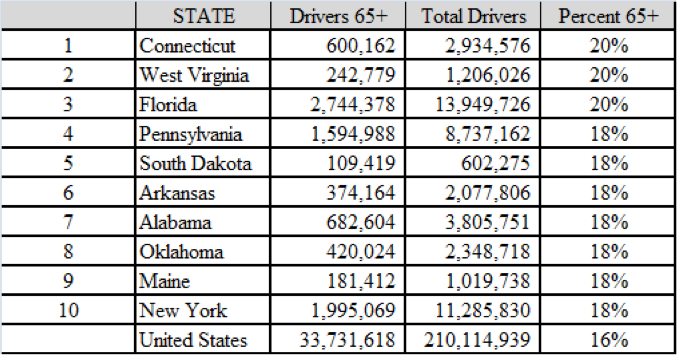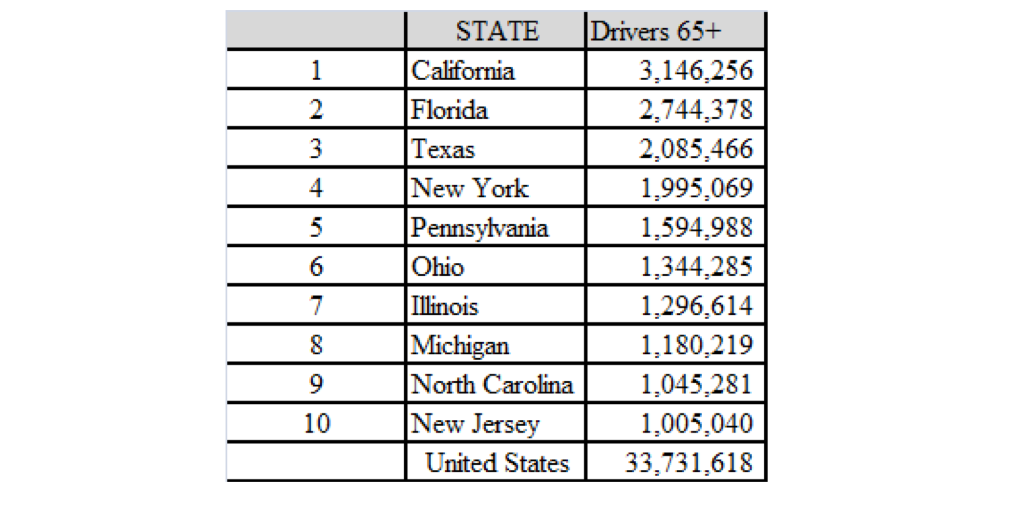AASHTO & TRIP
Executive Summary
With the first wave of the Baby Boom Generation turning 65 in 2011, the number of older Americans and their share of the population will begin to grow significantly in the coming years. And as this generation continues to age and grow, it will demand a level of mobility and an active lifestyle that far outpaces any of America’s previous generations. This aging population will both create and face significant transportation challenges, including a transportation system that lacks many features that would accommodate the level of mobility and safety older Americans desire and expect. Transportation innovations to accommodate the Baby Boom Generation’s need for improved safety and mobility will benefit users of all ages.
For older Americans, as well as the population in general, the ability to travel represents freedom, activity and choice. Older Americans prize their mobility and active lifestyles and want to maintain them as long as possible. For many older people, driving remains the safest, easiest and most convenient means of transportation.
Although overall traffic fatality rates have fallen to record lows in recent years, older drivers still make up a disproportionately high share of those involved in fatal traffic crashes. Roadway safety improvements designed to make it easier for older drivers to navigate traffic are becoming increasingly important, as the largest generation in American history grapples with the effects of aging while trying to maintain a level of mobility that matches its active lifestyle.
This report explores mobility and safety issues for older Americans and presents a set of recommendations for implementing a transportation system that can better serve the safety and mobility needs of older Americans and the population at large.
OLDER DRIVER DEMOGRAPHICS
As the Baby Boom Generation ages, older Americans form a greater portion of the
overall population and a greater share of all licensed drivers.
• Americans aged 65 and older account for 13 percent of the total population. This group increased by two percent each year between 2001 and 2009.
• The number of older Americans will only increase, as Baby Boomers began to turn 65 in 2011. Over the next 15 years, the population of Americans 65 and older is projected to grow by 60 percent.
• Thirty-four million licensed drivers in the U.S. are 65 or older. Currently, 16 percent of the licensed drivers in the U.S. are 65 or older, up from 14 percent in 2000. Projections show that one in every five drivers will be 65 or older by 2025.
• Older men drive more than women of the same age, although the gap is narrowing. While 89 percent of men 65 and older continue to drive, only 73 percent of women in the same age group drive. Because they outnumber men, there are more 65 and older female drivers than men.
• Older Americans tend to “age in place”, remaining in the homes where they raised their children and held jobs. Seventy-nine percent of elderly Americans live in suburban (56 percent) or rural (23 percent) communities.
• The states with the highest percentage of drivers 65 and older are Connecticut, West Virginia, Florida, Pennsylvania, South Dakota, Arkansas, Alabama, Oklahoma, Maine and New York.
 • The ten states with the greatest total number of licensed drivers age 65 and older are California, Florida, Texas, New York, Pennsylvania, Ohio, Illinois, Michigan, North Carolina and New Jersey.
• The ten states with the greatest total number of licensed drivers age 65 and older are California, Florida, Texas, New York, Pennsylvania, Ohio, Illinois, Michigan, North Carolina and New Jersey.
Download full report (PDF): Keeping Baby Boomers Mobile
About AASHTO
www.transportation.org
“AASHTO is a nonprofit, nonpartisan association representing highway and transportation departments in the 50 states, the District of Columbia, and Puerto Rico. It represents all five transportation modes: air, highways, public transportation, rail, and water. Its primary goal is to foster the development, operation, and maintenance of an integrated national transportation system.”
About TRIP
tripnet.org
“Founded in 1971, TRIP is a nonprofit organization that researches, evaluates and distributes economic and technical data on surface transportation issues. TRIP promotes transportation policies that relieve traffic congestion, improve road and bridge conditions, improve air quality, make surface travel safer and enhance economic productivity. TRIP is sponsored by insurance companies, equipment manufacturers, distributors and suppliers, businesses involved in highway and transit engineering and construction, labor unions, and organizations concerned with an efficient and safe surface transportation network.”
Tags: AASHTO, American Association of State Highway and Transportation Officials, Baby Boomers, TRIP







 RSS Feed
RSS Feed